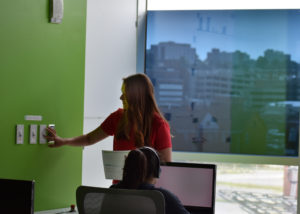In 2017, SyracuseCoE catalyzed a new study on the effect of daylighting on cognitive performance in the workplace. The study compares two different window technologies: conventional roller window shades and electrochromic glazing that changes tint in response to sensors or occupant control.
“We are trying to find out if there is a correlation between an office environment that has better lighting conditions and exposure, and its effect on certain cognitive function,” says Tarek Rakha, assistant professor at Syracuse University’s School of Architecture and an expert in daylighting in built environments.
Too much glare or brightness through a window causes thermal discomfort and visual disturbances that can make occupants uncomfortable. This is especially true in high-performance buildings, which are designed to optimize the capture of daylighting.
Rakha conceived the Daylighting for Cognition study to take advantage of a new installation of SageGlass, an electrochromic “smart” glass on the SyracuseCoE’s third floor. He engaged collaborators from Syracuse University’s Department of Psychology in the College of Arts and Sciences and the Lighting Research Center at Rensselaer Polytechnic Institute to gauge its impact.
SageGlass, produced by SAGE Electrochromics, Inc., is an electronically tintable, energy-efficient glazing solution for windows, skylights, and curtain walls that actively manages solar heat and glare without blocking the view to the outdoors.
Rakha was inspired by a previous project that studied the impact of indoor air quality on cognitive function, The COGfx Study, conducted by researchers at Harvard University, Upstate Medical University, and Syracuse University in SyracuseCoE’s Total Indoor Environmental Quality Lab in 2014. Thinking about current interest in environmental factors and human wellbeing, Rakha wondered if the technology used on building window envelopes—and the resulting interior daylight—can impact the cognitive performance of workers compared to traditional envelopes. Sage was excited about the notion of looking beyond building performance, occupant visual or thermal comfort, and further into the impact on occupant well-being, a new frontier in the research of sustainability.
To create this indoor environmental quality study, Rakha brought together an interdisciplinary team, including Michael Kalish, Syracuse University professor of psychology; Mariana Figueiro, director of the Lighting Research Center; and Chetna Chianese, associate director of research at SyracuseCoE. Syracuse University architecture undergraduate student Emily Greer served as a research assistant for the project. Figueiro, a leader in lighting research, was recruited to assist with experimental design and data analysis, providing short term performance tests used successfully in the past and a sensor to measure circadian effective light.
“The idea is to be able to measure how much circadian light people are being exposed to,” Figueiro says. “The hypothesis is that if you’re exposed to a greater amount of circadian light during the daytime, that you’re going to be more alert. And if you’re more alert, you will perform better on these performance tests and perhaps on cognition.”
But that’s a big if. “We’re exploring the question objectively,” says Rakha. “We cannot say for sure that they’re going to be more productive.”
To that end, he recruited Kalish, who has conducted theoretical research on the mechanisms responsible for cognitive function. The psychologist provided a tool to measure cognitive function precise enough to vary with changes in mood or wakefulness that the study aims to cause, and he is analyzing data collected along with his graduate student, Osung Seo.
To test their hypothesis, 60 participants were recruited to come to SyracuseCoE headquarters and work in office space during five sunny days in June and July 2017, when the sun was at its highest angle. Participants worked in an office environment with regular window roller shades, as well as a duplicate environment with SageGlass electrochromic glazing. During the course of their workday, participants took part in various performance and cognitive function tests. This process will be repeated in September and October, when the sun is at a lower angle.
“We wanted people to come in and do their normal tasks to see how they reacted to the various daylighting and assess how that affects them,” says Greer, a research assistant at SyracuseCoE’s Performative Praxis Lab, who managed the process to secure approval of the research protocol by Syracuse University’s Institutional Review Board, led recruitment of study participants, and oversaw technology used
for the project.
Documenting a connection would be an important finding, says Figueiro. “There are so many things in the built environment that may affect cognition, it’s hard to tease out the effect. If the study can make that link, it would definitely be novel.”
Regardless of the results, Rakha says the study illustrates the importance of the SyracuseCoE in catalyzing research and innovation in sustainable technologies.
“We could not do this project without SyracuseCoE facilities or the leadership SyracuseCoE provides for faculty and researchers in the area,” he says, pointing to the SageGlass installation, SyracuseCoE’s existing relationship with SAGE and RPI’s Lighting Research Center, and the research support provided. “The SyracuseCoE building is fantastic for testing the technological frontiers of the building itself, but it’s the people that provide the conduit and network to make it happen.”

